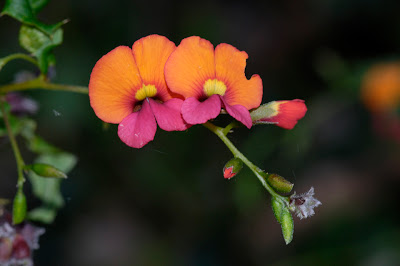… and also of the ‘cones’ of Banksia grandis, a large bush. The aborigines use this plant for all sorts of purposes – the dried flowers can be used as tinder for fire-lighting, glowing cones for carrying fire from one settlement to another, and, extraordinarily, they made a glue from the plant (used, among other things, for attaching arrow heads to the shafts) that has only been surpassed in strength and hardness in the last few decades by epoxy resins.
The jarrah forest at Dwellingup is a biodiversity hotspot, and there was an abundant range of wild flowers:
One of the most interesting plants, was a small sundew that I was surprised to find growing on the dry forest floor. Viewed from standing the plants were rather non-descript and easily overlooked, but up close the modified insect-catching leaves were like exquisitely worked glass:
I was told to watch out for orchids on the forest floor, but also that they are scarce this year because of the unusually dry winter. I drew a blank until I was leaving and came across a woman who was a keen orchid hunter and busy photographing an extraordinary bird orchid:

Heading to another spot in the car, I stopped to watch a flock of red-tailed cockatoos. These are one of the largest cockatoos, and their languid flight over the jarrah forest is a magnificent sight. These ones were busy feasting on jarrah fruits, and I was subjected to a constant rain of discarded fruits as I stood under the trees where they were feeding:
My destination was a short walk in a river valley. The path descended on the sunny side of the valley, where there were more wild flowers …

… - including an orchid with streamer like petals (or are they sepals?) …
... and the ugliest lizard I have ever seen:
It’s called a shingleback, and they are slow-moving, so it is easy to get close to them. Too close, though, and they threaten you in startling fashion. Apparently the bite is vice-like.

In the shady ascent on the other side of the valley, there were fewer flowers, but I found a third sundew species, this one a climber:
It was time to move on again, and head for my final stop of the day, a long thin brackish water lake which is one of the few non-marine homes to thrombolites. To the untrained eye, thrombolites look like so many rounded-Gouda-shaped rocks of varying sizes strewn along the water’s edge. In fact, the ‘rocks’ are gradually built up by single-celled organisms that have descended almost unchanged from 600 million year old ancestors – a period before the first multi-cellular organisms evolved. There is a board walk built a short way out into the lake to view the thrombolites. What I hadn’t reckoned on was the stiff southerly breeze which had piled the water up and covered the thrombolites. The choppy water surface reduced the thrombolites to vague underwater forms. It seemed somehow appropriate that the fates that arrange such things had not gone out of their way to accommodate my short visit, less than the smallest of blips in the history of these ancient life forms.



















The flowers are wonderful but those orchid are out of this world Kate.
ReplyDeleteThe lizard looks great with its mouth open!
You'll have to go back again to catch the thrombolites in better weather. Though they look really interesting.
chp
I am so enjoying my trip down under
Hi Kate,
ReplyDeleteI've just clicked onto the photo of the climbing orchid. Is that a spider's web wrapped round it, or part of the flower?
chp
Climbing sundew (not orchid)? I think it's spider's web. I'd noticed it on some other photos but not on that one. It also runs off to the left from the 'leaf' to something out of the photo. Perhaps the spider steals food out of the mouths of the sundew (they're insectivorous plants)? Their flowers are absolutely fantastic, but I didn't see any in flower.
ReplyDelete"Climbing sundew."
ReplyDeleteI really ought to read your info better. I thought that was the flower. If not they must look stunning when they are.
Looking forward to the next episode. :O)
chp.
Better go to bed, it's after 11.30 here. Got to be up early in the morning for lessons. Night night.
I love the sundews. So charming! The other flowers are gorgeous, too. I, too, am enjoying the trip.
ReplyDelete